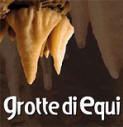|
WHAT TO SEE

Karst-Palaeontological Park
of the
Caves in Equi Terme
It comprises
facilities and tourist tours of a number of geosites and archaeosites,
situated one near the other, where cultural, naturalistic and geological
elements are enhanced.
It is formed by a perpetual karst spring [Buca di Equi Terme], some
caves of palaeoetnhological and palaeontological interest [Tecchia di
Equi Terme and Tana della Volpe (the fox’s den)], various thermal
springs (radioactive thermo-sulphurous springs in Equi Terme) and paths
along a deeply and vertically carved river stretch (Solco di Equi).
The Buca di Equi Terme (Equi Terme’s Hollows), whose discovery dates
back to centuries ago, is a special karst geomorphosite. It was already
described in 1726 and the first tourist activities started in 1964. It
was reopened in 2001.
The cave stretches over a total of 1,500 m and is characterized by a
single itinerary of 320 m. The cave is situated in a small area which also includes the
prehistoric site of Tecchia.
The Museum of the “Grotte” (Caves) has been set up for tourists and
schools. It is an educational exhibition on the physical landscape of
surrounding areas and it reconstructs the palaeoenvironment in which
Neanderthal men coexisted with cave bears.
|
ApuanGeoLab is a modern space of interactive activities,
dedicated to the Earth Sciences. It is based on the Geolab of San Gemini
(Terni), with the aim of offering a unique scientific experience from tourists and schools.
Here every
visitor is a “geologist for a day”, starting on a journey that provides
an explanation of the physical and chemical mechanisms which have formed
and shaped the planet. The Earth’s interior and convection cells are the
key-words in the first room; the second room is dedicated to
plate tectonics theory and its effects on a global and local scale. It also
describes the endogenous and exogenous forces that formed and then
shaped the Apuan Alps. In the final room the visitor can observe the
column representing the Apuan Alps “stratigraphy” in which every rock
tells its story...
ApuanGeoLab also has an equipped laboratory in
order to educational activities in Earth Sciences. This completes a
progressive and structured program.
VISITOR TRAIL
1.
Geologist for a day
2. A slice of Earth
3. At the centre of the Earth
4. Coming back to home
5. Landmasses on the move
6. It’s all a quake
7. Stone by stone
8. Mountains appear
9. From limestone to marble
10. Caves: wells and galleries
11. The giants pots
12. Equi geosites
13. From Thetys Ocean to
Mediterranean Sea
14. The Apuans in the geologic time
|

|